1. Upper Bloem
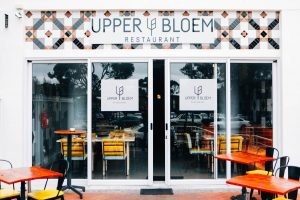
Upper Bloem
South African cuisine generally struggles with an identity crisis. There are so many different cultures and influences to the country that it’s hard to pin down a quintessential style of cooking that forms a specific South African culinary identity. The food cooked in homes across the country is based largely on family recipes handed down through generations, but is considered just that – home cooking, as opposed to a single, definitive cuisine.
Upper Bloem seeks to take one of those ‘home cooking’ cuisines and spin it into a culinary experience that’s uniquely South African – or, at least, definitive to a particular cultural group. Chef Andre Hill and his team have deconstructed the flavours, spices, textures, colours and inspirations of his youth and applied a modern touch. The result is a heady ‘Cape Malay’ style food experience, heightened by fine dining technique, while remaining deferential to the humble origins of the food.
Upper Bloem is a sister restaurant to La Mouette, with Hill having started at the Sea Point eatery as Sous Chef in 2013 and impressing Chef Patron Henry Vigar with his command of flavour and technique that the two partnered to co-create and co-own the new restaurant in 2017.
The location is slightly innocuous, in a mini roadside shopping centre of sorts, not at all in keeping with the homely and very traditional ‘Bo Kaap’ area from which it draws its history. The interior is welcoming, though, and the geometric tiles which line the walls do pay tribute to the heritage of the food in both colour and form. It’s a small space, with the open-plan kitchen dominating one side – cosy without being cramped.
The menu follows the La Mouette premise – dinner is generally presented in three courses, each featuring around three dishes, although a la carte is also an option. It’s utterly worth following the set menu, for the sake of the journey through the flavours and textures composed so lovingly by the team in the kitchen.
The small plates look nothing like the home-style meals which influence them, but contain all of the flavours – hits of coriander, judicious garlic and deep spice mixes. It’d be a brave venture to take your expert home cook mother in law to a restaurant like Upper Bloem – she’d probably shudder at the ‘fancy’ non-traditional presentations of dishes like Bunny Chow and Samp & Beans, but grudgingly declare the flavours utterly present and authentic.
Alcohol isn’t a common part of traditional Cape Malay culture, often for religious reasons, but the wine pairings to the set menu at Upper Bloem really add another dimension to the food experience – worth trying for a small surcharge.
Visit the official website at: www.upperbloemrestaurant.co.za
2. The PotLuck Club
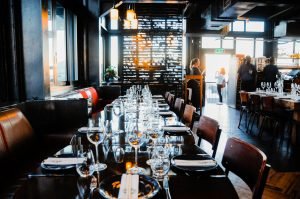
The Pot Luck Club
Chef Luke Dale-Roberts’ restaurant empire continues to grow, particularly across the Cape, where he presides over Africa’s best restaurant (The Test Kitchen), as well as in partnerships with The Shortmarket Club, The Commissary and Salsify at The Roundhouse. The PotLuck Club was his second restaurant after The Test Kitchen and is also housed within The Old Biscuit Mill in Woodstock. The two restaurants have led the gentrification of the gritty suburb, south of the Cape Town CBD and helped turn it into a creative hub.
While The Test Kitchen offers diners a lavish 21-course tasting menu that requires a move between two differently-styled spaces to manage the sensory explosion – and has a waiting list that’d be the envy of any restaurant – The PotLuck Club is a far simpler, yet no less robust restaurant.
Housed atop the flour silo at The Old Biscuit Mill, it has near-360 degree views of Cape Town and the two dinner seatings are most desirable, to catch the sun dipping over the harbour as Table Mountain and Lion’s Head merge into the darkening sky. As is the style with most of Dale-Roberts’ restaurants, the open kitchen is prominent, but not imposing. Décor – all his restaurants are styled by his wife, Sandalene – is slick and relatively minimalist. It’d be hard to compete with the views of one of the world’s most beautiful cities from the tall windows, so why try? There is space for 120 diners – and almost every seat is almost certainly spoken for, at each service.
The Asian-influenced tapas menu is divided into sections based on the five tastes: salty, sour, sweet, bitter and umami. There’s also always a special or two available, handwritten on the checklist-style order sheet. Diners can obviously choose freely, but the highly-trained floor staff will suggest an order for courses to maximise the taste journey, and the kitchen fires out dishes as soon as they’re ready. Central to the kitchen – and, indeed, the menu itself – is a giant Robata grill, which imparts a smoky charcoal-grilled flavour to many elements. From ‘Salty’, expect dishes like Doenjang glazed Tuna; from ‘Umami’: Truffle & Asparagus Tarte Fine; Hoisin & Ponzu Beef Tataki for ‘Sweet’; Ash-Roasted Vegetables with fermented turnip for ‘Sour’ and interesting desserts like an Orange & Olive Oil Cake with Crème Fraiche Ice Cream.
The team behind the bar mix a mean cocktail for the perfect aperitif, and the wine list has some interesting options, which the front of house staff are able to expertly pair with the menu selections. It’s no mean feat to match wines with such varied tapas flavours, but their success rate is pretty high.
For an utterly decadent, but relaxed, experience book a table for Sunday brunch to enjoy a concise menu along the same 5-taste lines as lunch and dinner and bottomless bubbly – with those astonishing views.
Visit the official website at: www.thepotluckclub.co.za
3. The Foodbarn
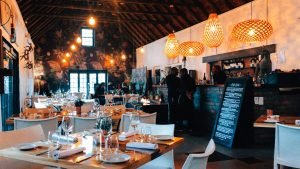
The Foodbarn
Any restaurant that sits at the end of the one of the world’s most scenic roads has a lot to live up to. The staggeringly beautiful drive from Cape Town, along Chapman’s Peak Drive towards the Southern Peninsula is one of the world’s finest, with breathtaking vistas unfurling around each treacherous corner. As the winding pass descends to sea level, the quaint Noordhoek Farm Village sits to the left. The unassuming complex just happens to be home to The Foodbarn – one of the Cape’s finest eateries.
Chef Franck Dangereux’s restaurant has seemingly been here forever, serving remarkable food that belies its rural-looking location. Without being a million miles from town itself, it’s still something of a ‘country destination’ – time moves at a different pace on this end of Table Mountain.
Inside the Cape Dutch-styled barn is a warm space, with a vaulted roof and a central fireplace for days when the famous Cape winds make things a little unpleasant outside. Some conceptual sculptures line the walls and the table settings are simple – nothing here detracts from the food itself.
The Foodbarn’s menu is seasonal, inscribed on hefty chalk boards that the wonderful front of house team tote from table to table. It’s fine dining – but with a casual twist. There’s certainly plenty of variety, from broccoli gratin and excellent steak tartare to start, through to an unusual tomato, basil & parmesan risotto and lamb rack for mains. The dessert menu – a separate board – offers innovative home-made sorbets, a chocolate pavé & banana brûlée and an astonishing ‘orange & berries’, gratinated in an almond sabayon. Each dish comes with a suggested ‘by the glass’ wine pairing, with the extensive list – which blends old favourites and the exciting work of the industry’s young guns – also open for exploration.
Plating isn’t overly flashy – smears, espumas and emulsions would never survive on this end of ‘Chappies’ – but that doesn’t mean there’s a shortage of technique. The impression that each dish gives as it emerges from the kitchen is that it’s been carefully put together from start to finish by one chef, rather than finished on a production line. Flavours are hearty and clean, there’s clear quality to each ingredient and every element is treated respectfully.
Visit the official website at: www.thefoodbarn.co.za
4. The Commissary
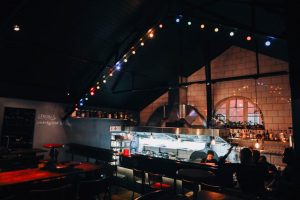
The Commissary
If you like street food reduced to its essence and then given a kick in the pants, The Commissary is your kind of restaurant. They only open for dinner, they don’t take reservations, the menu doesn’t have a clear origin and they play their music a little too loud. And it’s perfect.
Chef Wesley Randles and his team have taken inspiration from global travels and brought home an array of dishes they’ve transformed to the point that you probably won’t find them on a menu anywhere else in the world. The menu shifts constantly, and while a few favourites make Recurring Guest Star drop-ins, the team generally have free rein to put together imaginative combinations that make each visit, refreshing.
Calling the food ‘punchy’ is an understatement – if something has been prepared in the wood-burning oven, it’s a smoky Islay kick in the teeth. Umami somehow arrives as the harmonising finish to a dish that crackles with layers of flavours that fight for attention on a single plate. If they tell you something is spicy – believe them. If there’s a theme to be had, it’s remotely Asian – potent house-made XO sauce pops up in a few dishes, Nahm Jim threatens to overpower oysters before becoming the perfect counterpoint to the base saltiness and an improbable gorgonzola tahini with pecan nuts and immolated pancetta somehow transform a boring wedge of lettuce into one of the tastiest things you’ll ever put in your face, in your life.
But then you glance down the menu – inscribed on the wall next to the bathroom door – and you’ll find things like Mortadella sliders (on fresh, house-made potato buns) and the fudgiest of fudge brownies (with the nitrogen peanut butter topping you never knew you needed in your life) and you’ll start to understand that great food doesn’t need a theme – it just needs to tell a story.
Randles oversees the kitchen at both The Commissary and adjacent Shortmarket Club, so he regularly uses the interleading door to pop in and out. One minute he’s discussing the ratio of fish sauce to caramel in a proposed pork spare rib dish with his Sous Chef and the next, he’ll be next door, plating something elaborate with tweezers. It’s a delicious contrast that evidently stokes the imagination.
Follow The Commissary on Facebook for updates of regular themed evenings. Sometimes they’ll focus their full attention on working up wild and wonderful pizzas. On other special nights, sliders are the star of the show. One of the best things about the restaurant is that you never know what you’re going to get – you just know it’s going to be great.
Visit the official website at: www.thecommissary.co.za
5. La Tête

La Tête
Chef Giles Edwards practices what others preach, bringing true ‘farm to fork’ eating to the heart of Cape Town – establishing a loyal following and picking up several awards in the process.
When the restaurant launched, the media hype was very much around Giles’ seven years spent alongside pioneering ‘nose-to-tail’ guru Fergus Henderson at St John in London – and what that meant for his offering in Cape Town. Yes, ‘Brains on Toast’ was a controversial addition to the Mother City’s dining scene, but it’s also not utterly outlandish. Giles is at pains to point out that this way of eating isn’t trendy – it’s simply the way millions of people around the world eat to survive on a daily basis. It’s more sustainable, more environmentally friendly, more ethical and possibly, healthier – so the initial hype around a ‘Fear Factor’ type dining experience puzzled him. Fortunately, it didn’t take Capetonians long to get over themselves and the restaurant immediately found itself on several awards lists. Thoroughly candid, Giles, still expresses surprise at how his relatively pared down offering finds itself alongside that of restaurants offering more ‘fine dining’ food. The answer is simple – the food is fresh, local and consistently tastes amazing.
The La Tête location is unassuming and the décor sparse – it’s at the bottom end of Bree Street and the interior seems mostly inspired by a minimalist gallery, between exhibitions. Table settings are simple – white linen tablecloths only make an appearance at dinnertime. All of this, though, serves as the canvas to Giles’ work. The food is, quite simply, astonishing and the rotating daily menu begs repeat exploration to experience the full gamut of both produce and technique.
The major favourites on the menu – which guests return for again and again – include Mussels Leeks & Bacon, Grilled Green Beans, Goats Cheese & Mint, Chicken Liver Parfait, Octopus, Fennel & Sea Spinach and Linefish, White Beans & Green Sauce. Hardly the horror scene that people imagine when they hear ‘nose-to-tail’, though anyone not used to eating the less popular cuts from an animal will be greatly rewarded for stepping vaguely outside of their comfort zone – and they’ll wonder how it is that they haven’t always eaten this way. It’s possible to have an amazing meal at a relatively affordable price, too, with menu items rarely topping the R200 mark – the average three-course dinner will set you back around R400 per head, plus wine from the concise, but interesting list. Intriguingly, despite the image that the concept conjures up, there are actually plenty of vegetarian-friendly dishes on the menu, which is refreshing.
As for dessert, well, look no further than the Madeleines. Made to order in portions of 6 or 12, the 15-minute wait is rewarded by a plate of pillowy soft biscuits and an unctuous custard that’s worth saving the space for. It’s not a revolution, it’s just food – but it’s damn good food made by someone with a clear vision, and the skill to pull it off.
Giles regularly wanders out of the compact kitchen to chat to guests and see how particular dishes are genuinely being received. Engage him on his passion and you’ll learn more about food in the space of five minutes than you will have, in all your preceding years.
Visit the official website at: www.latete.co.za
6. La Mouette
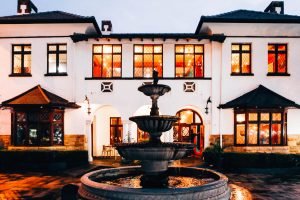
La Mouette
La Mouette must be one of Cape Town’s best-kept secrets. It’s been around nearly a decade now, but it’s still something of an ‘in the know’ location for locals and savvy visitors – not that it isn’t always busy, but its reputation is still mostly low-key.
‘The Seagull’ is set in an impossibly beautiful Tudor house – with a delightful cobblestone courtyard which benefits from the relaxing susurration of cascading water from the giant central fountain, setting the scene for languid lunches and romantic dinners under the Cape Town stars in the summer months. The interior has had several modernising updates over the last 9 years and the current iteration is probably more minimalist than it has been in the past – but it’s still welcoming, with high ceilings and fireplaces that are a huge bonus in winter.
The food offering is built around two and three course options (with several choices per course) and optional wine pairings. Bearing in mind the quality of ingredients and imagination involved in preparation and presentation, the 3 course option with wine pairing (R785) is tremendous value for money. Opting out of the wine pairing cuts the cost to R450 (two courses for R350), which is relatively ‘bargain basement’ for food of such style and substance. If you opt against the wine pairing, there are plenty of wonderful by-the-glass and bottle options – and the sommelier loves a challenge! There’s also often a Winter Special menu which keeps things ticking over at even more remarkable value at a time when many other Cape restaurants shutter themselves until the throngs of tourists return – and a dedicated vegan offering that doesn’t take any shortcuts on flavour.
The kitchen team still features several members of the original staff, with Chef Patron Henry Vigar’s pedigree, impeccable, thanks to stints at several fine dining establishments in the UK, Australia and France to his credit. The front of house staff are also wonderfully knowledgeable with plenty of suggestions and a deep understanding of every dish on the menu – it’s an area which trips up many a service team who have to deal with a constantly-shifting menu.
Book a table in the courtyard during the warmer months for a magical al fresco experience that belies the city centre location.
Visit the official website at: www.lamouette-restaurant.co.za
7. Chefs Warehouse & Canteen
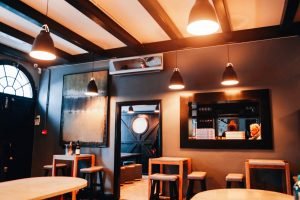
Chefs Warehouse & Canteen
Chefs Warehouse has grown beyond its Cape Town CBD base, with award-winning outposts established in Constantia and Franschhoek – but the original claims a spot on our list for the role it’s played in establishing Bree Street as one of the finest food streets in the world, and the value represented by its offering.
The property’s evolution into one of the city’s finest restaurants has been quirky, to say the least. Established as a cookery school and store which stocked supplies for the city’s burgeoning chef population in 2010, a tapas restaurant was established in 2014, with the latest iteration now home to a wine bar and restaurant – sans educational and retail options.
Its offering remains simple – and refreshing: it’s only open for lunch and dinner Monday-Friday, doesn’t accept reservations, and offers a set-price tapas menu for two (currently R750) as its sole dining offering. Seasonal risotto is a fixture, and the multiple courses arrive in three ‘tranches’ – multiple dishes to a ‘course’ that maximise the sharing potential and allows the kitchen a measure of control over the dining experience. Still, the menu changes just about daily and marries seasonal ingredients with astonishing technical skill to produce dishes that are as eye-catching as they are tasty. It’s fine dining, simplified – and democratized, to an extent, by the limitation of options and removal of lengthy advance booking requirements. Desserts are more of a fixture on the menu and are available as an optional extra.
Sister restaurants Chefs Warehouse at Beau Constantia and Chefs Warehouse at Maison both offer a slightly more refined experience – both have eclipsed the original by claiming spots on the nationwide EatOut Top 20 list – but that privilege comes with a price premium, as well as the requirement to make advance bookings. Part of the charm of Chefs Warehouse & Canteen is the chance to join the inevitable queue ahead of lunch or dinner and enjoy one of the city’s finest meals, without having to plan months ahead.
If the queue gets too long or you can’t grab a table right away, the space is now home to a particularly stylish wine bar, where you can enjoy wines from unusual producers, a selection of innovative cocktails and a decent list of spirits and coffees, while you wait for your name to rise to the top of the waiting list.
The setting is cosy and stylish – and blissfully peaceful, thanks to the small number of seats available. Long tables are shared, making for a somewhat communal, yet still very personal meal. The service is thorough and attentive and the addition of the wine bar has significantly bulked up the wine list, with – gloriously – 99% of the offering available by the glass.
Bag a spot on the bar stools along the patio in summer to watch the city start to sizzle as the sun sets.
Visit the official website at: www.chefswarehouse.co.za/bree
Get us in your inbox
The Seven Best is an online guide featuring curated lists of must-sees, must-dos and more as you plan your journey around South Africa.
By filling this form I agree to the privacy policy.



